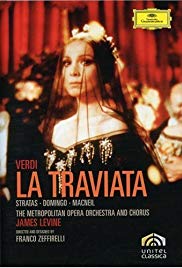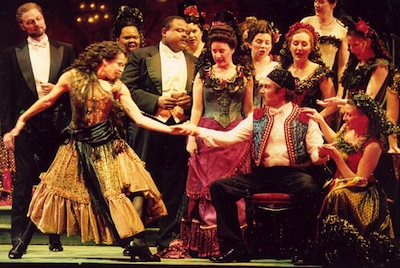LA TRAVIATA
SUBJECTS — Music/Opera; World/France;
SOCIAL-EMOTIONAL LEARNING — Romantic Relationships;
MORAL-ETHICAL EMPHASIS — Respect.
AGE: 12+; MPAA Rating — G;
Opera; 1982; 105 minutes; Color. Available from Amazon.com.
There is NO AI content on this website. All content on TeachWithMovies.org has been written by human beings.

SUBJECTS — Music/Opera; World/France;
SOCIAL-EMOTIONAL LEARNING — Romantic Relationships;
MORAL-ETHICAL EMPHASIS — Respect.
AGE: 12+; MPAA Rating — G;
Opera; 1982; 105 minutes; Color. Available from Amazon.com.
TWM offers the following worksheets to keep students’ minds on the movie and direct them to the lessons that can be learned from the film.
Film Study Worksheet for a Work of Historical Fiction and
Worksheet for Cinematic and Theatrical Elements and Their Effects.
Teachers can modify the movie worksheets to fit the needs of each class. See also TWM’s Historical Fiction in Film Cross-Curricular Homework Project.
Zeffirelli’s “La Traviata” is a cinematically creative version of Verdi’s beautiful and classic opera. In this movie, the music is enhanced by strikingly beautiful visual images.
Selected Awards:
1983 Golden Globe Awards Nominations: Best Foreign Film; 1982 Academy Award Nominations: Best Art Direction/Set Decoration, Best Costume Design.
Featured Actors:
Teresa Stratas, Placido Domingo, Cornell MacNeil.
Director:
Franco Zeffirelli.
Conductor/Musical Director:
James Levine.
This film will introduce children to a beautiful opera and to a classic story of love and tragedy. It is helpful to the psychological development of children to vicariously experience and work through the pain of lost love. Stories such as “La Traviata” are a vehicle for this process. The film will also introduce the demimonde of the 19th century.
MINOR. In the early scenes there is much celebration with drinking and high times through which the participants seek to avoid the emptiness of their lives. For Violetta, these entertainments turn sour and irrelevant compared to Alfredo’s love.
Before watching the movie briefly describe the demimonde for your child. After viewing the film ask and lead your child through an answer to the Quick Discussion Question.

“La Traviata” is based upon a play, “La Dame Aux Camelias” (The Lady of the Camellias, 1852) by Alexander Dumas, the Younger. The play, in turn, was based on the life of Marie Duplessis who died of tuberculosis in 1847. She was 24 years old when she died. Her grave is located in Paris. It is reported that to this day people put flowers on the grave of Mme. Duplessis. The play was popularized in the United States under the name “Camille” and was made into a wonderful 1936 motion picture starring Greta Garbo. See Learning Guide to Camille. Verdi adapted the opera from the play.
Violetta was a member of the “demimonde,” women who gave their favors to wealthy “protectors” under arrangements that were often contractual. Women of the demimonde were often independent and sometimes lived lavishly. While the courtesans of the demimonde had a social standing well below that held by women of unquestioned “virtue” and respectability, they were not considered prostitutes. The demimonde was an institution in France for many decades.
It would have brought shame on a “respectable” family if a son married a woman of the demimonde. See also Gigi, in which the prospective benefactor ultimately decides to marry his love rather than relegate her to the life of a courtesan. There is merit in showing children Camille, “La Traviata” and Gigi in that order. If your child is not familiar with the story of “Camille” when they see “La Traviata” it is probably best to describe the plot of this film version of the opera before viewing it. The plot is set out below:
As the film opens, workmen are carting off Violetta’s possessions which have been sold to pay her debts. She is dying of consumption (an old and non-scientific term for tuberculosis) and waiting for Alfredo to come and save her. The opera itself takes place in a flashback of Violetta’s recollections of her life.
In the flashback, Violetta is under the “protection” of Baron Douphol. It is a loveless relationship and Violetta doubts that she will ever merit anyone’s love. She has recently recovered from a long and serious bout with consumption but is by no means cured.
Alfredo, a handsome young man, declares his love for her and Violetta wonders, should she dare hope? Alfredo and Violetta retire from society for several months to a country villa. Here Violetta finds happiness. But this is shattered when Alfredo’s father appears and requests that she break off the relationship. Alfredo’s sister is engaged to be married but, if word of his liaison with Violetta were to get out, the engagement would be terminated. For the sake of Alfredo’s family, Violetta promises to abandon Alfredo. She leaves for Paris and in a note, tells Alfredo that she has grown tired of him and of their dull life and has gone back to the Baron. Alfredo believes her note and he too returns to Paris.
At a party, Alfredo enters and then Violetta. Alfredo gambles with the Baron, bets recklessly and wins. Violetta and Alfredo meet privately and he angrily presses her for an explanation. She cannot explain without breaking her promise to his father. Alfredo, in a rage, drags Violetta to where the guests are assembled and insults her by throwing his winnings at her, stating that they are payment for their time together. Violetta is shamed. The crowd is outraged at Alfredo’s conduct, as is Alfredo’s father who has come upon the scene. The Baron challenges Alfredo to a duel.
The flashback ends and Violetta receives a letter from Alfredo’s father. He writes that he has told Alfredo of Violetta’s sacrifice and that Alfredo will be coming to see her soon. Alfredo does come and Violetta dies in his arms.
Why subject children and yourself to this sad tale? The answer lies, not only in the psychological benefits of working through this tragedy, but in the transcendent beauty of the music, especially the arias, including: “Libiamo”(The Drinking Song), “Dite Alla Giovane,” “Piangi, O Misera” and “Parigi, O Cara.”
1. See Discussion Questions for Use With any Film that is a Work of Fiction.
2. What was the underlying social “need” that caused the demimonde to flourish?
[Some of the reasons are the powerlessness of women and the insistence on the “purity” of women considered suitable for marriage.]
1. Why didn’t all the drinking and partying satisfy Violetta?
Discussion Questions Relating to Ethical Issues will facilitate the use of this film to teach ethical principles and critical viewing. Additional questions are set out below.
(Treat others with respect; follow the Golden Rule; Be tolerant of differences; Use good manners, not bad language; Be considerate of the feelings of others; Don’t threaten, hit or hurt anyone; Deal peacefully with anger, insults, and disagreements)
1. Can there be a truly romantic relationship between a man and a woman of the demimonde? What is missing?
This Learning Guide was last updated on December 10, 2009.